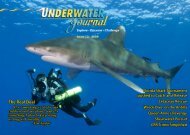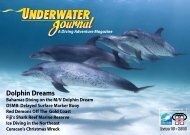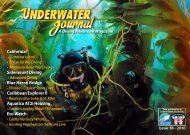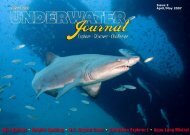- REBREATHERS - SPORT DIVERS ... - Stingray Divers
- REBREATHERS - SPORT DIVERS ... - Stingray Divers
- REBREATHERS - SPORT DIVERS ... - Stingray Divers
You also want an ePaper? Increase the reach of your titles
YUMPU automatically turns print PDFs into web optimized ePapers that Google loves.
Like all polycheates, marine<br />
worms belonging to the Phylum<br />
Annelida, the giant St.Lucia<br />
Thing’s (Eunice roussaei) body<br />
is divided into a repetitive<br />
sequence of round segments<br />
(reddish brown to purple with<br />
a pearl-like tint) separated by<br />
deep creases.<br />
Like a centipede, large<br />
cirri (appendages used for<br />
locomotion) and feather shape<br />
gills flank both sides of this<br />
huge marine worm.<br />
no matter how improbable it might seem,<br />
I planned a few night dives. Much to my<br />
surprise, I found that The Thing really did<br />
exist, and I was even able to get a picture<br />
of it!<br />
It was a fairly small specimen compared to<br />
what the divemasters had described - about<br />
four feet in length and as thick as my wrist.<br />
But it didn’t recoil from the light. Maybe it<br />
was sick.<br />
Excited by my discovery, I passed a few<br />
images on to my good friend Paul Humann. He<br />
was working on the second revision of his and<br />
Ned Deloach’s Reef Creature Identification<br />
book, so I figured if anyone could, Paul could<br />
identify it.<br />
As it turned out, this was a new species<br />
never before identified. The best any of the<br />
scientists were able to do was determine it<br />
belongs to the Phylum Annelida, meaning little<br />
rings, which is applied to most segmented<br />
worms. “Common earthworms, as well as<br />
many marine worms are members of this<br />
phylum,” according to Paul.<br />
This group’s most distinguishing<br />
characteristic is that their body is divided into<br />
a repetitive sequence of round segments. The<br />
marine variety are known as polycheates.<br />
Examples would include the beared fireworm<br />
(Hermodice carunculata) commonly called<br />
bristle worm. Differing on this creature, body<br />
segments of dark to reddish/purple brown<br />
with a pearl-like tint, separated by deep<br />
creases with large cirri (appendages used<br />
for locomotion) and feather shaped gills that<br />
are soft to the touch (yes, I touched one)<br />
running down both sides, looking sort of like<br />
a centipede.<br />
The identification of the Thing is tentative,<br />
as more taxonomic research needs to<br />
be done once viable specimens or tissue<br />
samples are obtained. Problem is not only<br />
are they nocturnal, they are still considered<br />
extremely rare, with only a handful sightings<br />
in Bonaire, Curacao and the Bahamas, in<br />
addition to St. Lucia.<br />
For the moment, all anyone can say is that<br />
it belongs to the Family of elongated worms<br />
Eunicidae, giving rise to its genies species<br />
name: Eunice roussaei. And that it inhabits<br />
deep recesses in the reef, and can grow up<br />
to six feet in length.<br />
The last part is speculative, since scientists<br />
are really not sure how big this animal grows.<br />
Who knows, there may be a 15-foot monster<br />
out there on the reef. It may be you who will<br />
find it. v<br />
www.underwaterjournal.com June/July 2007






